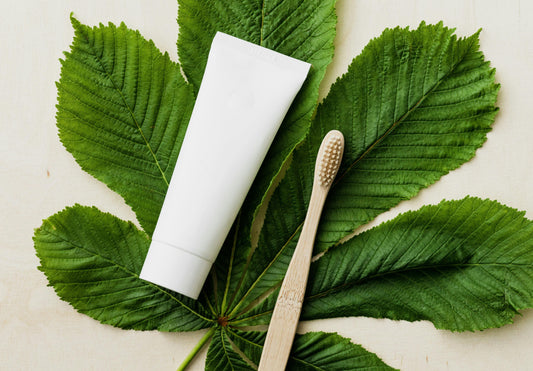Similarly to our gut, the human skin is also the home of millions of microorganisms, bacteria, fungi and viruses that make up the skin microbiota. These microorganism live in symbiosis with us and have an essential role in protecting us from pathogens, supporting our immune system.1
The Gut-Skin Microbiome Connection
The skin microbiome and gut microbiome are distinct yet interconnected ecosystems within the human body. Their interaction and mutual influence are areas of active research, revealing important insights into how they collectively impact health and disease. Here are some key points highlighting their connection:
-
Immune System Modulation
The gut microbiome plays a critical role in training and modulating the immune system. A healthy gut microbiome promotes a balanced immune response, which can affect skin health. Dysbiosis in the gut (an imbalance in the microbial community) can lead to systemic inflammation, which may manifest as skin conditions like acne, eczema, and psoriasis.2
- Metabolite Production
During the fermentation of dietary fibres, Short Chain Fatty Acids (SCFAs) such as butyrate, acetate, and propionate provide anti-inflammatory effect and can influence skin health by modulating immune responses and maintaining the integrity of the skin barrier. -
Microbial Translocation
Bacteria and their metabolic products from the gut can enter the bloodstream (a phenomenon known as microbial translocation) and potentially influence the skin microbiome and immune responses in the skin.
-
Dietary Influences
The gut microbiome aids in the digestion and absorption of nutrients that are crucial for skin health, including fatty acids, amino acids, and micronutrients.3
Skin Microbiome & Ageing
The skin microbiome undergoes significant changes as a person ages, impacting skin health and appearance. Understanding these changes provides insights into how the microbiome influences the ageing process. In youth, the skin microbiome tends to be more diverse, with a balanced mix of bacterial species, while as people age, microbial diversity often decreases. Certain beneficial bacteria diminish, while other potentially pathogenic species may increase. Certain bacterium that are associated with acne in young individuals, tends to decrease with age, however other species are more dominant on ageing skin, which can affect skin health and resilience.
As the skin’s barrier function weakens with age, it is leading to increased dryness and changes in the lipid composition of the skin surface. This can alter the habitat for skin microorganisms too. Ageing skin often has a higher pH, which can favour the growth of certain bacteria over others. Moreover, hormonal changes, particularly during menopause, can impact skin properties and subsequently the skin microbiome.4,5
What Can You Do This Weekend?
There are several strategies for maintaining healthy skin that are easy to implement in your daily routine and life:
- Probiotics & Prebiotics
Skincare products rich in pro- and prebiotics can help maintain or restore a healthy skin microbiome, potentially reducing inflammation and supporting skin health. Oral probiotics might also influence the skin microbiome by modulating the gut-skin axis. - Skincare Routines
Using gentle, non-drying cleansers can help maintain the skin’s natural barrier and pH, supporting a healthy microbiome, while regular use of moisturisers can combat dryness and support the skin barrier, creating a favourable environment for beneficial microbes. - Lifestyle Factors
A balanced diet rich in antioxidants, vitamins, and minerals supports overall skin health and a healthy microbiome, and protecting the skin from UV damage helps preserve its structure and function, indirectly supporting the microbiome. Getting adequate sleep, quitting smoking and avoiding stress can further protect our skin from premature ageing.6,7
It is important to be mindful when using skincare products, as many of them can contain various ingredients that may be harmful or irritating to the skin, especially with prolonged use. Some of the most common damaging ingredients are:
- Parabens
Used as preservatives to extend shelf life, however linked to hormone disruption and potential carcinogenic effects. - Phthalates
Used to increase flexibility and softness of plastics, often found in fragrances, however associated with endocrine disruption and reproductive toxicity. - Sodium Lauryl Sulfate (SLS) and Sodium Laureth Sulfate (SLES)
Commonly used as foaming agents and detergents, but can cause skin irritation and strip natural oils, leading to dryness and sensitivity. - Synthetic Fragrances
Added for scent, however often composed of multiple chemical compounds, which can cause allergic reactions, irritation, and may contain endocrine disruptors. -
Mineral Oil
Used as a moisturising agent, but can clog pores and is derived from petroleum, raising environmental concerns.
-
Alcohol
Used as astringents and preservatives. Can be very drying and irritating to the skin, especially in high concentrations.8,9
Safer alternatives can be natural preservatives such as vitamin E, or rosemary extract. Try and opt for fragrance-free or naturally scented products using essential oils. Use sulphate-free cleansers to avoid stripping natural oils. Become familiar with ingredient labels and avoid known harmful substances.10
The connection between the skin and gut microbiomes, as well as ageing is a fascinating area of study, revealing that these two ecosystems are interdependent through immune modulation, metabolite production, microbial translocation, and dietary influences. Understanding this relationship opens up new avenues for holistic approaches to treating skin conditions, emphasising the importance of gut health in maintaining overall skin health.






